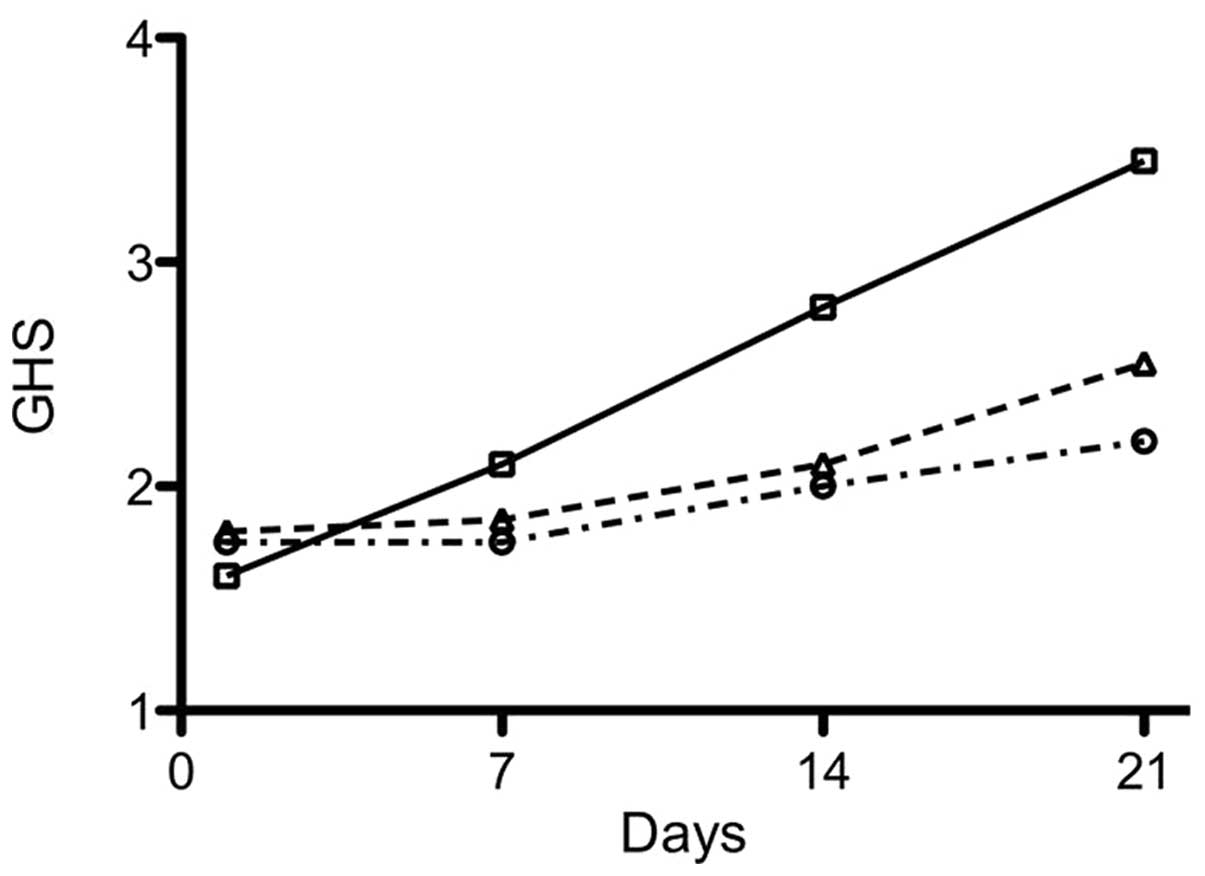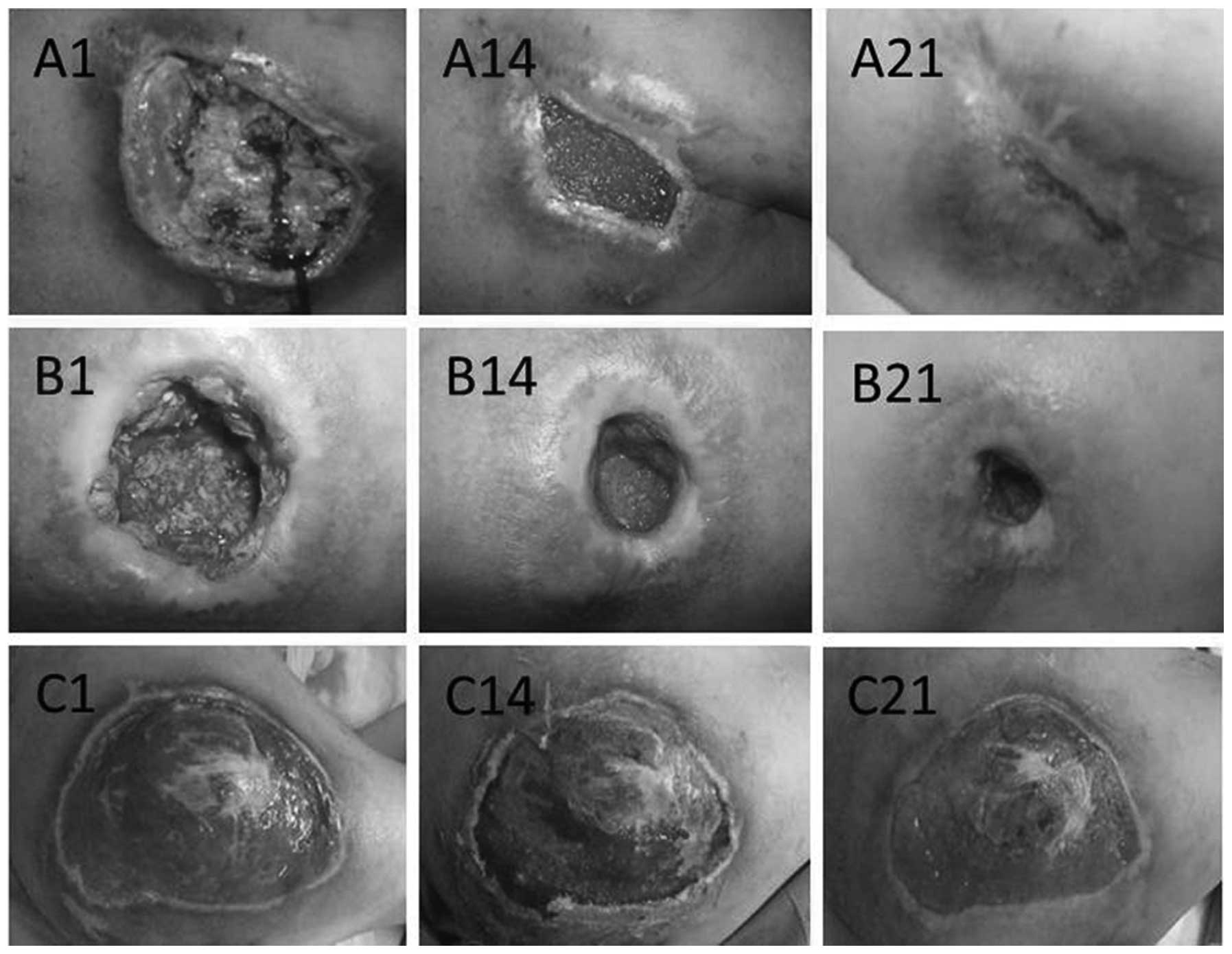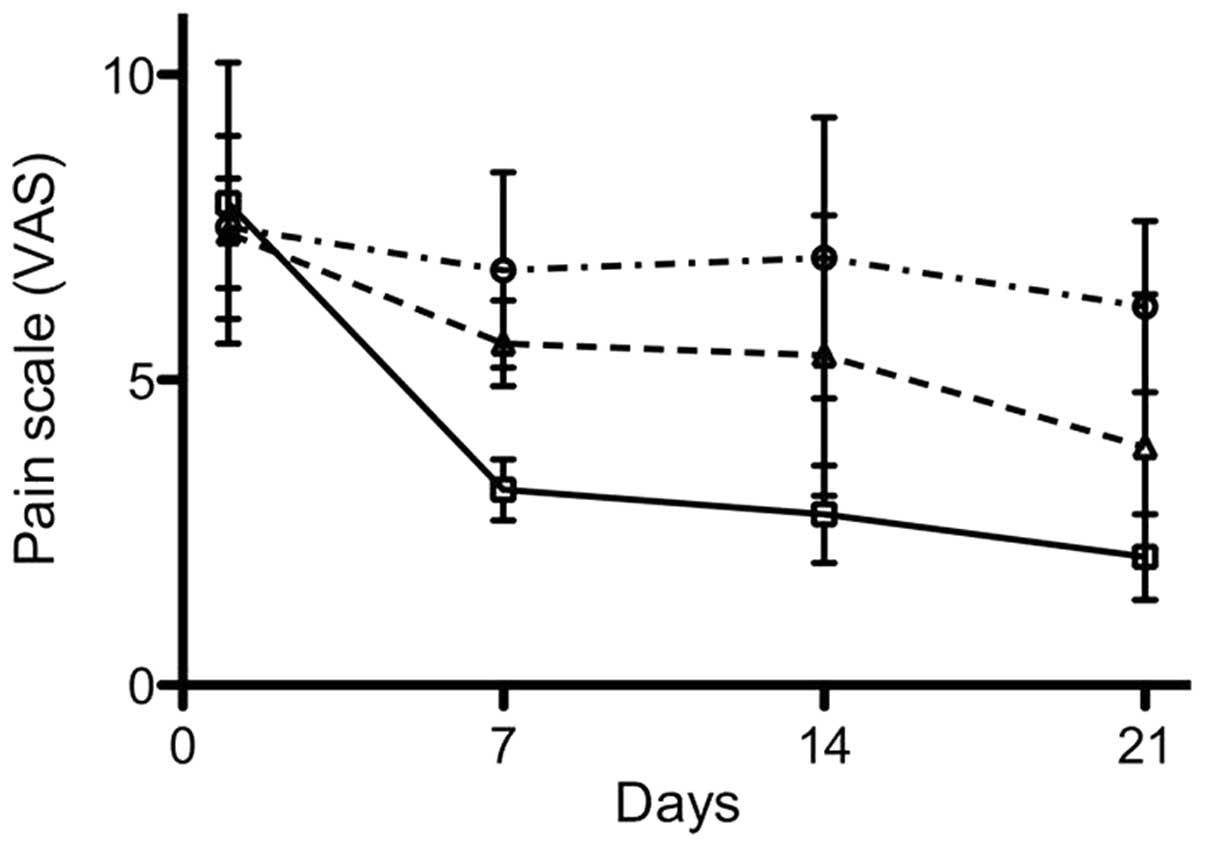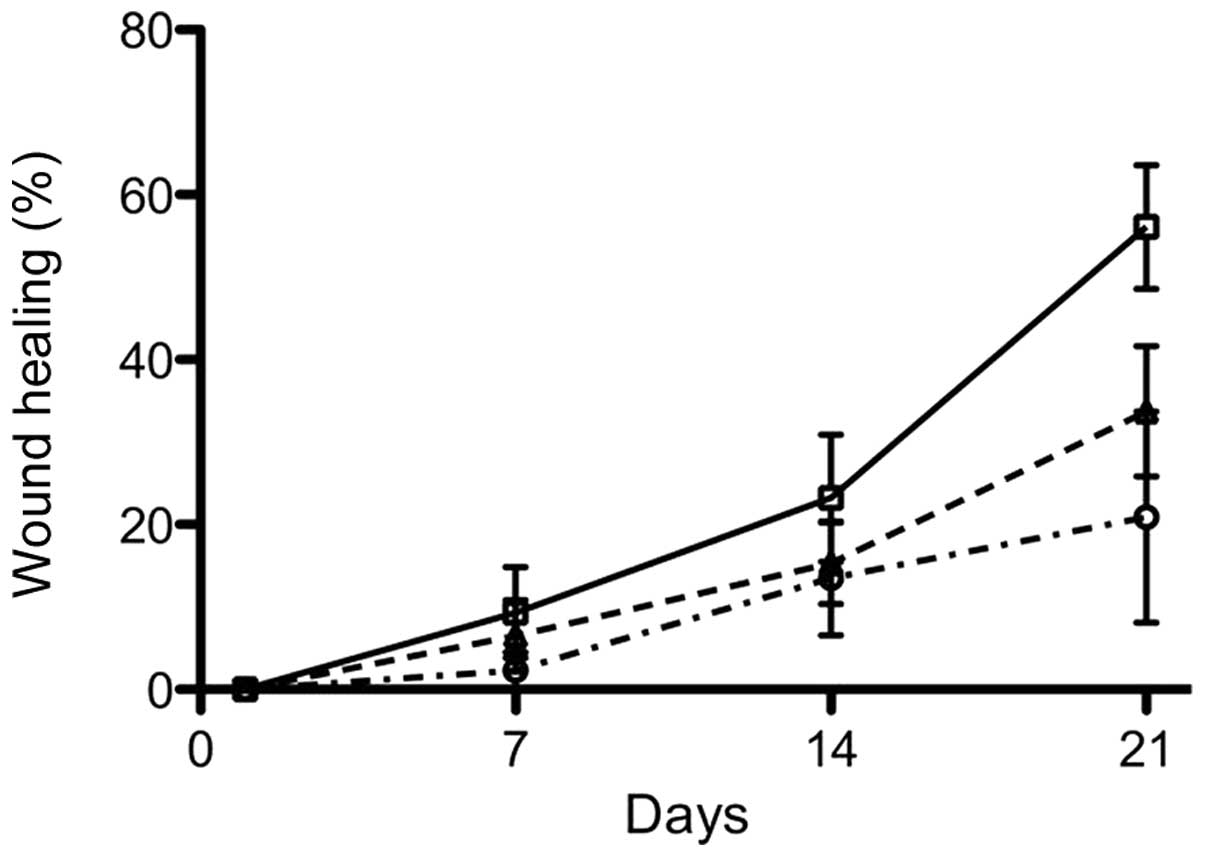|
1
|
Barnard J and Millner R: A review of
topical hemostatic agents for use in cardiac surgery. Ann Thorac
Surg. 88:1377–1383. 2009. View Article : Google Scholar : PubMed/NCBI
|
|
2
|
Niemi T, Svartling N, Syrjälä M,
Asko-Seljavaara S and Rosenberg P: Haemostatic disturbances in
burned patients during early excision and skin grafting. Blood
Coagul Fibrinolysis. 9:19–28. 1998. View Article : Google Scholar : PubMed/NCBI
|
|
3
|
Wee S and Gombotz WR: Protein release from
alginate matrices. Adv Drug Deliv Rev. 31:267–285. 1998. View Article : Google Scholar : PubMed/NCBI
|
|
4
|
Groenewold MD, Gribnau AJ and Ubbink DT:
Topical haemostatic agents for skin wounds: a systematic review.
BMC Surg. 11:152011. View Article : Google Scholar : PubMed/NCBI
|
|
5
|
Rabbany SY, Pastore J, Yamamoto M, Miller
T, Rafii S, Aras R and Penn M: Continuous delivery of stromal
cell-derived factor-1 from alginate scaffolds accelerates wound
healing. Cell Transplant. 19:399–408. 2010. View Article : Google Scholar : PubMed/NCBI
|
|
6
|
Kolambkar YM, Dupont KM, Boerckel JD,
Huebsch N, Mooney DJ, Hutmacher DW and Guldberg RE: An
alginate-based hybrid system for growth factor delivery in the
functional repair of large bone defects. Biomaterials. 32:65–74.
2011. View Article : Google Scholar : PubMed/NCBI
|
|
7
|
Lee KY, Peters MC and Mooney DJ:
Comparison of vascular endothelial growth factor and basic
fibroblast growth factor on angiogenesis in SCID mice. J Control
Release. 87:49–56. 2003. View Article : Google Scholar : PubMed/NCBI
|
|
8
|
Silva EA and Mooney DJ: Effects of VEGF
temporal and spatial presentation on angiogenesis. Biomaterials.
31:1235–1241. 2010. View Article : Google Scholar : PubMed/NCBI
|
|
9
|
Agren MS: Zinc in wound repair. Arch
Dermatol. 135:1273–1274. 1999. View Article : Google Scholar : PubMed/NCBI
|
|
10
|
Murakami K, Aoki H, Nakamura S, Takikawa
M, Hanzawa M, Kishimoto S, Hattori H, Tanaka Y, Kiyosawa T, Sato Y
and Ishihara M: Hydrogel blends of chitin/chitosan, fucoidan and
alginate as healing-impaired wound dressings. Biomaterials.
31:83–90. 2010. View Article : Google Scholar : PubMed/NCBI
|
|
11
|
Wiegand C, Heinze T and Hipler UC:
Comparative in vitro study on cytotoxicity, antimicrobial activity,
and binding capacity for pathophysiological factors in chronic
wounds of alginate and silver-containing alginate. Wound Repair
Regen. 17:511–521. 2009. View Article : Google Scholar
|
|
12
|
Hu X, Sun H, Han C, Wang X and Yu W:
Topically applied rhGM-CSF for the wound healing: a systematic
review. Burns. 37:729–741. 2011. View Article : Google Scholar : PubMed/NCBI
|
|
13
|
Mann A, Breuhahn K, Schirmacher P and
Blessing M: Keratinocyte-derived granulocyte-macrophage colony
stimulating factor accelerates wound healing: Stimulation of
keratinocyte proliferation, granulation tissue formation, and
vascularization. J Invest Dermatol. 117:1382–1390. 2001. View Article : Google Scholar
|
|
14
|
Zhang L, Chen J and Han C: A multicenter
clinical trial of recombinant human GM-CSF hydrogel for the
treatment of deep second-degree burns. Wound Repair Regen.
17:685–689. 2009. View Article : Google Scholar : PubMed/NCBI
|
|
15
|
da Costa RM, Aniceto C, Jesus FM and
Mendes M: Quick healing of leg ulcers after molgramostim. Lancet.
344:481–482. 1994.PubMed/NCBI
|
|
16
|
Ure I, Partsch B, Wolff K and Petzelbauer
P: Granulocyte/macrophage colony-stimulating factor increases
wound-fluid interleukin 8 in normal subjects but does not
accelerate wound healing. Br J Dermatol. 138:277–282. 1998.
View Article : Google Scholar
|
|
17
|
De Ugarte DA, Roberts RL, Lerdluedeeporn
P, Stiehm ER and Atkinson JB: Treatment of chronic wounds by local
delivery of granulocyte-macrophage colony-stimulating factor in
patients with neutrophil dysfunction. Pediatr Surg Int. 18:517–520.
2002.PubMed/NCBI
|
|
18
|
Jorgensen LN, Agren MS, Madsen SM,
Kallehave F, Vossoughi F, Rasmussen A and Gottrup F: Dose-dependent
impairment of collagen deposition by topical granulocyte-macrophage
colony-stimulating factor in human experimental wounds. Ann Surg.
236:684–692. 2002. View Article : Google Scholar
|
|
19
|
Breuhahn K, Mann A, Müller G, Wilhelmi A,
Schirmacher P, Enk A and Blessing M: Epidermal overexpression of
granulocyte-macrophage colony-stimulating factor induces both
keratinocyte proliferation and apoptosis. Cell Growth Differ.
11:111–121. 2000.
|
|
20
|
Jaschke E, Zabernigg A and Gattringer C:
Recombinant human granulocyte-macrophage colony-stimulating factor
applied locally in low doses enhances healing and prevents
recurrence of chronic venous ulcers. Int J Dermatol. 38:380–386.
1999. View Article : Google Scholar
|
|
21
|
Queen D, Orsted H, Sanada H and Sussman G:
A dressing history. Int Wound J. 1:59–77. 2004. View Article : Google Scholar
|
|
22
|
Winter GD: Formation of the scab and the
rate of epithelization of superficial wounds in the skin of the
young domestic pig. Nature. 193:293–294. 1962. View Article : Google Scholar
|
|
23
|
Yang Y, Wang J and Zhu L: Alginate
dressing application in plastic surgery. Journal of Chinese and
Western Medicine. 5:108–111. 2010.
|
|
24
|
Balakrishnan B, Mohanty M, Fernandez AC,
Mohanan PV and Jayakrishnan A: Evaluation of the effect of
incorporation of dibutyryl cyclic adenosine monophosphate in an in
situ-forming hydrogel wound dressing based on oxidized alginate and
gelatin. Biomaterials. 27:1355–1361. 2006. View Article : Google Scholar
|
|
25
|
Huang C, Wen X and Li G: Efficacy
observation and nursing for decubitus treated with Alginate
dressing. Modern Medicine & Health. 23:22007.
|
|
26
|
Ye Q and Chen J: Alginate dressing
application for skin graft on donor site. Zhejiang Medicine.
23:52001.
|
|
27
|
Da Costa RM, Ribeiro Jesus FM, Aniceto C
and Mendes M: Randomized, double-blind, placebo-controlled,
dose-ranging study of granulocyte-macrophage colony stimulating
factor in patients with chronic venous leg ulcers. Wound Repair
Regen. 7:17–25. 1999.PubMed/NCBI
|
|
28
|
Du S, Li Y, Mao Y, Sang X, Lu X, Wang W,
Zhang Q, Xue H, Yang X, Li S, Chi T, Zhong S and Huang J: Diagnosis
and treatment of hepatic angiomyolipoma. Hepatobiliary Surg Nutr.
1:19–24. 2012.
|
|
29
|
Kaplan G, Walsh G, Guido LS, Meyn P,
Burkhardt RA, Abalos RM, Barker J, Frindt PA, Fajardo TT and Celona
R: Novel responses of human skin to intradermal recombinant
granulocyte/macrophage-colony-stimulating factor: Langerhans cell
recruitment, keratinocyte growth, and enhanced wound healing. J Exp
Med. 175:1717–1728. 1992. View Article : Google Scholar
|
|
30
|
Siddiqui FH, Mokhashi MH and Boathman A:
Recombinant granulocyte-macrophage colony-stimulating factor in the
treatment of indolent ulcers with Klippel-Trenaunay-Weber syndrome:
a case report. J Pediatr Surg. 42:558–560. 2007. View Article : Google Scholar
|
|
31
|
Tursen U, Api H, Kaya TI, Cinel L and
Ikizoglu G: Rapid healing of chronic leg ulcers during perilesional
injections of granulocyte-macrophage colony-stimulating factor
therapy in a patient with cutaneous polyarteritis nodosa. J Eur
Acad Dermatol Venereol. 20:1341–1343. 2006. View Article : Google Scholar
|













